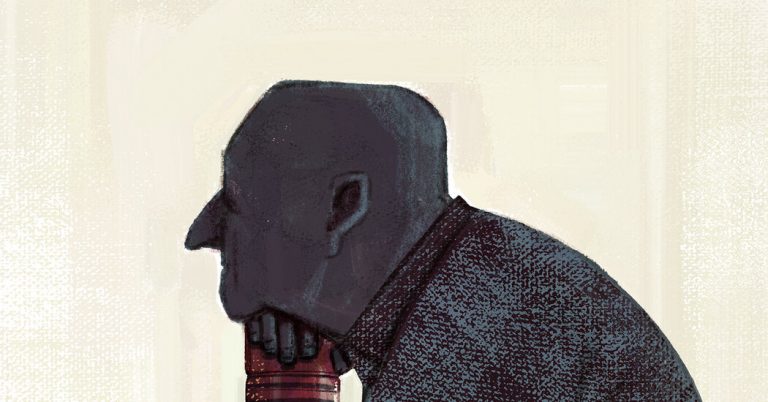The phone woke Doug Nordman at 3 in the morning. A surgeon was calling from a hospital in Grand Junction, Colorado, where Mr. Nordman's father had arrived in the emergency room, incoherent and in pain, and then lost consciousness.
Initially, staff thought he was suffering a heart attack, but a CT scan found that part of his small intestine had been perforated. A surgical team repaired the hole, saving his life, but the surgeon had some questions.
“Was your father an alcoholic?” he asked. Doctors found Dean Nordman malnourished, with his peritoneal cavity “filled with alcohol.”
The younger Nordman, a military personal finance author who lives on Oahu, Hawaii, explained that his father, 77, had long been a classic social drinker: a scotch and water with his wife before dinner, which was topped up during the dinner. , then another after dinner, and maybe a nightcap.
Drinking three to four drinks a day exceeds current dietary guidelines, which define moderate drinking as two drinks a day for men and one for women, or less. But “that was the normal drinking culture of the time,” said Doug Nordman, now 63.
At the time of his hospitalization, however, Dean Nordman, a retired electrical engineer, was widowed, living alone and developing symptoms of dementia. He got lost while driving, had difficulty with household chores and complained of “fading memory.”
He had rejected offers of help from his two sons, saying he was fine. During his hospitalization, however, Doug Nordman found almost nothing to eat in his father's apartment. Worse still, examining his father's credit card statements: “I saw recurring charges from the Liquor Barn and understood that he drank a pint of Scotch a day,” he said.
Public health officials are increasingly alarmed by older Americans' alcohol use. According to data recently released by the Centers for Disease Control and Prevention, the annual number of alcohol-related deaths from 2020 to 2021 exceeded 178,000 — more deaths than all overdoses combined.
An analysis by the National Institute on Alcohol Abuse and Alcoholism shows that people over 65 represent 38% of the total. From 1999 to 2020, the 237% increase in alcohol-related deaths among people over age 55 was greater than that of any age group except 25 to 34.
Americans largely fail to recognize the risks of alcohol, said George Koob, the institute's director. “Alcohol is a social lubricant when used according to guidelines, but I don't think they realize that when the dose increases it becomes a toxin,” he said. “And the older population is even less likely to recognize this.”
The growing number of older adults is responsible for much of the increase in deaths, Dr. Koob said. The aging population heralds a continuing surge that worries health care providers and advocates for older adults, even if older adults' drinking behavior does not change.
But things are changing. The percentages of people over 65 who report having consumed alcohol in the past year (about 56%) and in the last month (about 43%) are lower than all other adult groups. But older drinkers are significantly more likely to do so frequently, 20 or more days a month, than younger ones.
Additionally, a 2018 meta-analysis found that heavy drinking (defined as four or more drinks on a single occasion for women, five or more for men) had increased by nearly 40% among older Americans in the last 10-15 years.
What's going on here?
The pandemic clearly played a role. The CDC reported that deaths directly attributable to alcohol consumption, alcohol-related emergency room visits, and alcohol sales per capita all increased from 2019 to 2020, as Covid arrived and took effect of restrictions.
“A lot of stressors affected us: isolation, worries about getting sick,” Dr. Koob said. “They point to people drinking more to cope with that stress.”
The researchers also cite a cohort effect. Compared to those before and after them, “the boomers are a substance-using generation,” said Keith Humphreys, a psychologist and addiction researcher at Stanford. And they are not abandoning their youthful behavior, he said.
Studies also show a narrowing of the gender gap. “Women have been the drivers of change in this age group,” Dr. Humphreys said.
From 1997 to 2014, alcohol consumption increased by an average of 0.7% per year for men over 60, while excessive alcohol consumption remained stable. Among older women, alcohol consumption increased by 1.6% annually, while binge drinking increased by 3.7%.
“Contrary to stereotypes, educated upper-middle class people have higher rates of drinking,” Dr. Humphreys explained. In recent decades, as women became more educated, they entered workplaces where drinking was normative; they also had more disposable income. “Women who are retiring now are more likely to drink than their mothers and grandmothers,” he said.
However, alcohol use poses greater harm to older people, especially women, who become intoxicated more quickly than men because they are smaller and have fewer intestinal enzymes that metabolize alcohol.
Older adults might argue that they are simply drinking as they always have, but “equivalent amounts of alcohol have much more dire consequences for older adults,” whose bodies can't process it as quickly, said Dr. David Oslin, a psychiatrist at the University of Pennsylvania and the Veterans Affairs Medical Center of Philadelphia.
“It causes slower thinking, slower reaction times and lower cognitive ability as you get older,” he said, listing the risks.
Long associated with liver disease, alcohol “also exacerbates cardiovascular disease, kidney disease, and if you've been drinking for many years, there's an increase in some types of cancer,” he said. Drinking contributes to falls, a leading cause of injury as people age, and disrupts sleep.
Older adults also take many prescription drugs, and alcohol interacts with a long list of them. These interactions may be especially common with pain relievers and sleep aids such as benzodiazepines, sometimes causing excessive sedation. In other cases, alcohol can reduce the effectiveness of a drug.
Dr. Oslin warns that while many prescription bottles carry labels warning against using such drugs with alcohol, patients may shrug it off, explaining that they take the pills in the morning and don't drink until the evening.
“These drugs are in your system all day, so when you drink, there's still that interaction,” he tells them.
One proposal to combat alcohol abuse among older adults is to increase the federal tax on alcohol for the first time in decades. “Alcohol consumption is price sensitive, and it's quite cheap right now relative to income,” Dr. Humphreys said.
Resisting industry pressure and making alcohol more expensive, in the same way higher taxes have made cigarettes more expensive, could reduce its use.
The same could happen by eliminating barriers to treatment. Treatments for excessive alcohol use, including psychotherapy and medications, are no less effective for older patients, Dr. Oslin said. In fact, “age is actually the best predictor of a positive response,” he said, adding that “treatment doesn't necessarily mean you have to become abstinent. We work with people to moderate their alcohol consumption.”
But the 2008 federal law requiring health insurers to provide parity — the same coverage for mental health, including substance use disorders, as for other medical conditions — does not apply to Medicare. Several political and advocacy groups are working to eliminate such disparities.
Dean Nordman never sought treatment for his drinking, but after emergency surgery, his children moved him to a nursing home, where antidepressants and lack of access to alcohol improved his mood and his sociability. He died in the facility's memory care unit in 2017.
Doug, whom his father introduced to beer at 13, had himself been a heavy drinker, he said, “to the point of passing out” as a college student, and a social drinker thereafter.
But as he watched his father's decline, “I realized it was ridiculous,” he recalled. Alcohol can exacerbate the progression of cognitive decline and had a family history.
He has remained sober since that pre-dawn phone call 13 years ago.





